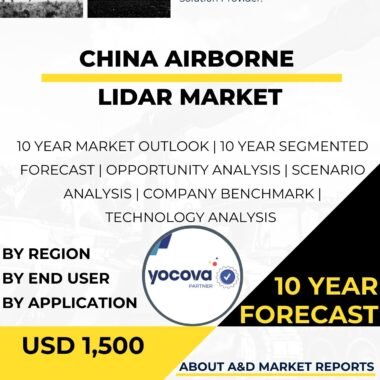Description
United States Airborne LiDAR Market
Airborne LiDAR (Light Detection and Ranging) technology has become a vital tool in various fields, providing detailed and precise three-dimensional data for a wide range of applications. By utilizing laser pulses to measure distances and create accurate point cloud representations of the Earth’s surface, Airborne LiDAR has revolutionized surveying, mapping, forestry, urban planning, environmental monitoring, and many other domains. This article will explore the development, capabilities, and significance of United States Airborne LiDAR Market technology in the and its impact on diverse industries.
The origins of LiDAR can be traced back to the early 1960s when laser technology was first used to measure distances. The term “LiDAR” was coined in the 1980s as laser technology evolved, enabling the measurement of distances with increased accuracy and precision. Early LiDAR systems were primarily ground-based, but as technology advanced, airborne LiDAR systems became more prevalent due to their ability to cover large areas quickly and efficiently.
Airborne LiDAR systems operate by emitting laser pulses toward the ground and measuring the time it takes for the laser light to bounce back after hitting a target. The return signals are used to calculate the distance between the LiDAR sensor and the ground surface. By mounting LiDAR sensors on aircraft, helicopters, or drones, large areas can be rapidly surveyed from the air, providing high-resolution data for various applications.
One of the primary applications of Airborne LiDAR is in topographic mapping and surveying. The technology offers a fast and accurate way to create digital elevation models (DEMs) and terrain models. These models are valuable in various industries, including civil engineering, land development, flood modeling, and disaster management.
Forestry and natural resource management are another critical domain where Airborne LiDAR is extensively used. By measuring the height and density of vegetation, LiDAR data assists in forest inventory, estimating biomass, and monitoring changes in forest ecosystems. It also aids in wildfire risk assessment and planning sustainable forestry practices.
Airborne LiDAR is particularly valuable in coastal and marine environments. By capturing the shape and elevation of shorelines and seafloors, LiDAR data is instrumental in coastal zone management, hydrographic surveys, and understanding coastal erosion and sedimentation patterns.
In urban planning and infrastructure development, Airborne LiDAR plays a crucial role in capturing detailed 3D information about cities and urban areas. LiDAR data is used to create precise digital surface models, analyze building footprints, assess urban growth patterns, and support city planning initiatives.
In addition to terrestrial applications, Airborne LiDAR is used in the aerial inspection of critical infrastructure, such as power lines, pipelines, and transportation networks. By generating accurate and comprehensive models of infrastructure assets, LiDAR helps in assessing structural integrity, identifying maintenance needs, and planning infrastructure upgrades.
The advent of Airborne LiDAR has also revolutionized archaeological and cultural heritage studies. The technology aids in the non-destructive documentation and analysis of historical sites and cultural artifacts, preserving valuable heritage for future generations.
Airborne LiDAR has had a significant impact on environmental monitoring and conservation efforts. It helps in monitoring deforestation, habitat changes, wetland mapping, and coastal erosion, providing crucial data for informed decision-making and sustainable environmental management.
The U.S. government, academia, and private industries have been at the forefront of Airborne LiDAR technology development and deployment. The U.S. Geological Survey (USGS) and National Aeronautics and Space Administration (NASA) have been actively involved in advancing LiDAR technology and incorporating LiDAR data into national mapping programs.
Private companies and research institutions in the U.S. have also made significant contributions to the evolution of Airborne LiDAR technology. Their efforts have led to the development of increasingly compact, lightweight, and cost-effective LiDAR systems, enabling more widespread adoption across various industries.
Despite its numerous advantages, Airborne LiDAR also faces challenges. One of the significant challenges is the massive amount of data generated during LiDAR surveys. Processing and managing such large datasets require specialized software, computational power, and skilled personnel.
Moreover, the accuracy and quality of LiDAR data can be influenced by various factors, such as weather conditions, flying height, and vegetation cover. These factors need to be carefully considered and accounted for during LiDAR data acquisition and processing.
To address these challenges and improve the capabilities of Airborne LiDAR, ongoing research and development efforts focus on enhancing data processing algorithms, refining sensor technologies, and integrating LiDAR data with other remote sensing techniques, such as aerial photography and multispectral imaging.
In conclusion, Airborne LiDAR technology has become a game-changer in surveying, mapping, environmental monitoring, and various other domains. Its ability to rapidly capture accurate and detailed three-dimensional data from the air has transformed industries and enabled innovative applications in the United States and worldwide. As the technology continues to advance, the significance of Airborne LiDAR in supporting decision-making, enhancing resource management, and advancing scientific research will only grow, making it a valuable tool in addressing contemporary challenges and improving our understanding of the Earth’s surface and environment.




